Dissertation: Benefits of Fundraising Events for London Churches
VerifiedAdded on 2021/04/17
|54
|14133
|71
Dissertation
AI Summary
This dissertation investigates the benefits of fundraising events for church organizations in London, focusing on the Love of Christ Generation Church. It explores the rationale behind these events, including the need for financial support for community initiatives and the challenges faced in attracting donors. The research includes a literature review of fundraising theories, such as Relationship Fundraising, and examines the principles, advantages, and disadvantages of fundraising events. The methodology involves a positivism philosophy, deductive approach, and descriptive research design, using both quantitative and qualitative data collected through surveys of 150 volunteers and interviews with 3 priests. The findings highlight that fundraising events help churches increase donations, improve public relations, and secure grants, while also facing challenges related to resources. The dissertation concludes with recommendations for optimizing fundraising efforts, such as developing clear goals, utilizing relationship marketing, and increasing media coverage. The study also identifies areas for future research.

Running head: DISSERTATION
Dissertation
The Benefits of Fundraising Events for Church Organisations in London
Student’s name:
Name of the university:
Author’s note:
Dissertation
The Benefits of Fundraising Events for Church Organisations in London
Student’s name:
Name of the university:
Author’s note:
Paraphrase This Document
Need a fresh take? Get an instant paraphrase of this document with our AI Paraphraser
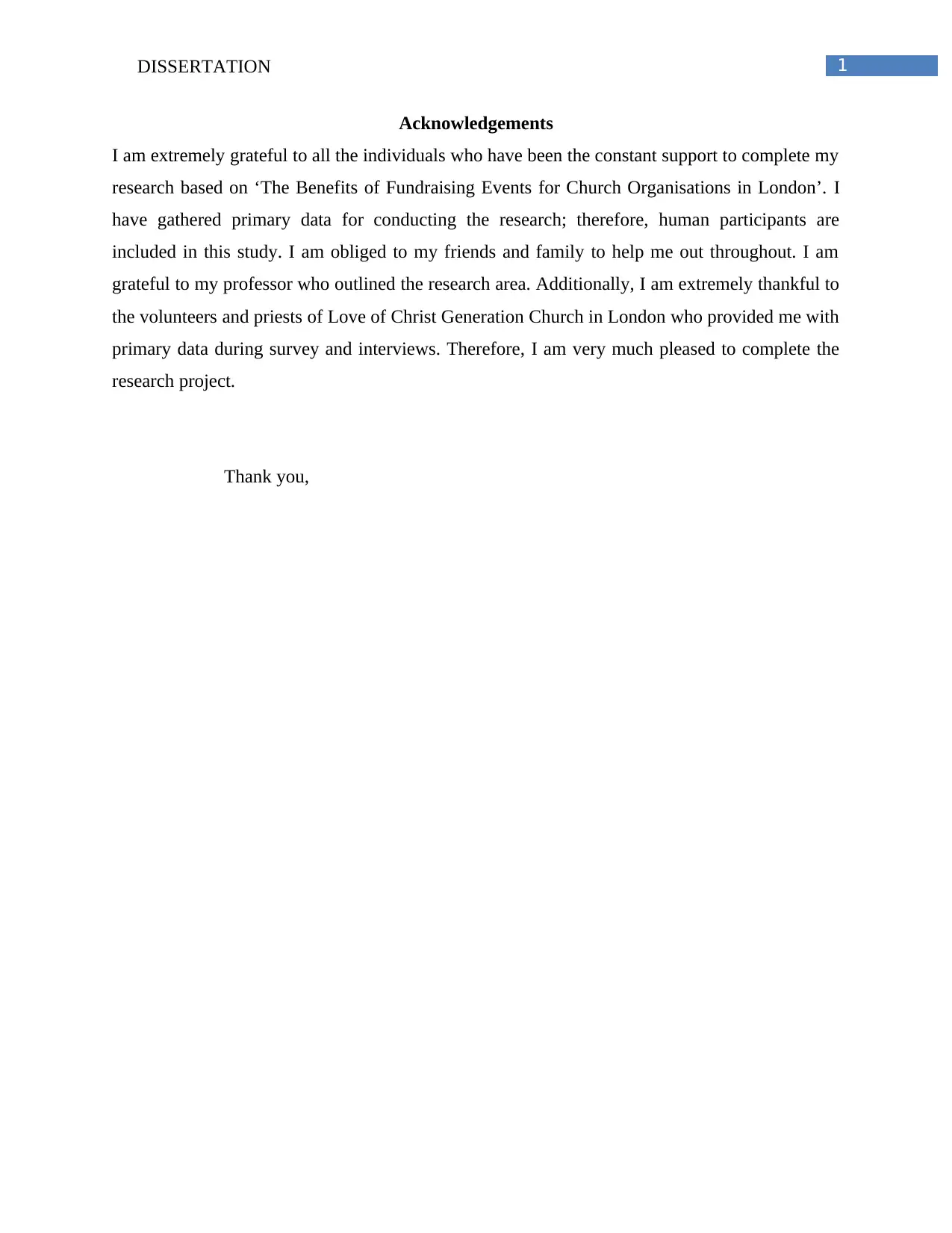
1DISSERTATION
Acknowledgements
I am extremely grateful to all the individuals who have been the constant support to complete my
research based on ‘The Benefits of Fundraising Events for Church Organisations in London’. I
have gathered primary data for conducting the research; therefore, human participants are
included in this study. I am obliged to my friends and family to help me out throughout. I am
grateful to my professor who outlined the research area. Additionally, I am extremely thankful to
the volunteers and priests of Love of Christ Generation Church in London who provided me with
primary data during survey and interviews. Therefore, I am very much pleased to complete the
research project.
Thank you,
Acknowledgements
I am extremely grateful to all the individuals who have been the constant support to complete my
research based on ‘The Benefits of Fundraising Events for Church Organisations in London’. I
have gathered primary data for conducting the research; therefore, human participants are
included in this study. I am obliged to my friends and family to help me out throughout. I am
grateful to my professor who outlined the research area. Additionally, I am extremely thankful to
the volunteers and priests of Love of Christ Generation Church in London who provided me with
primary data during survey and interviews. Therefore, I am very much pleased to complete the
research project.
Thank you,
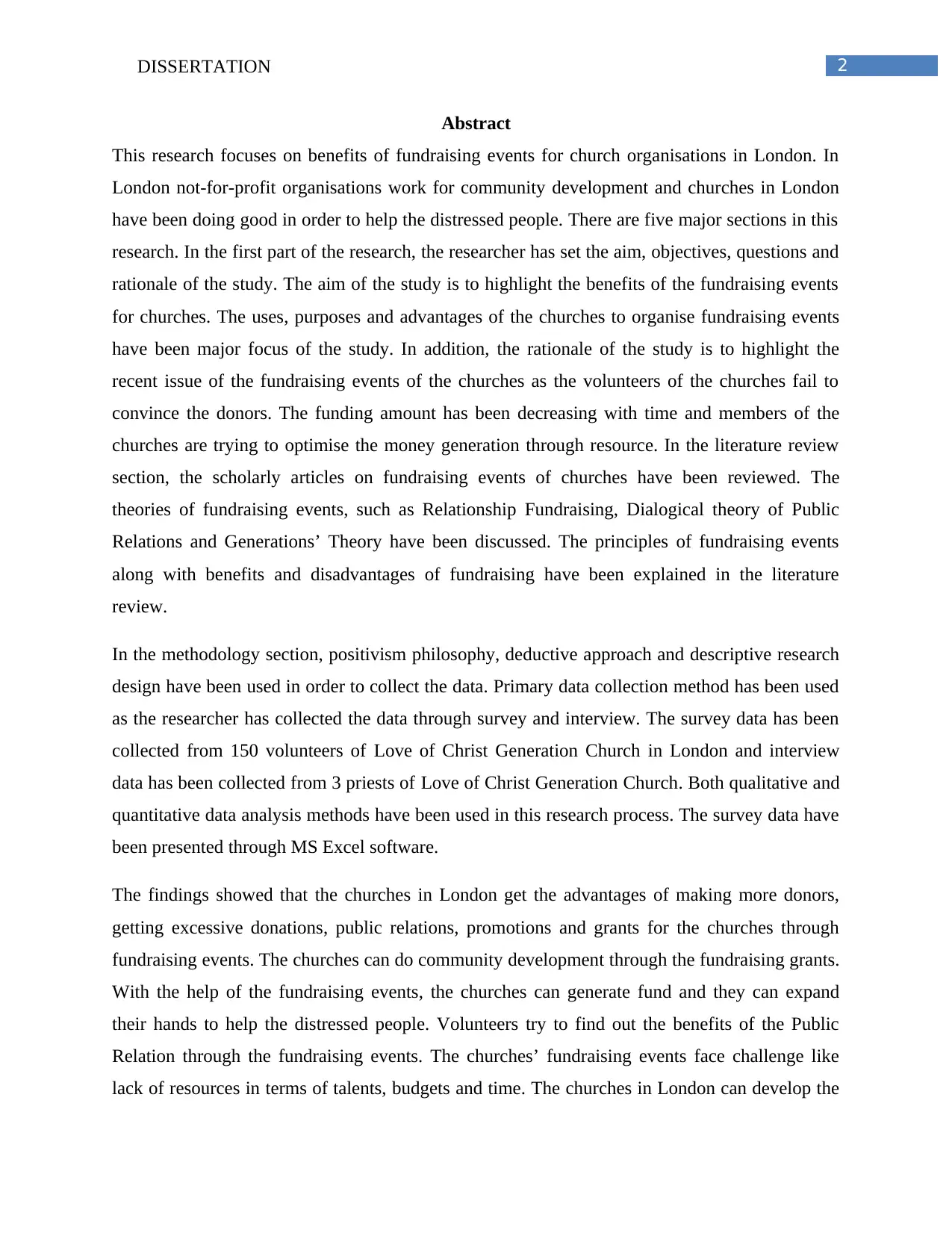
2DISSERTATION
Abstract
This research focuses on benefits of fundraising events for church organisations in London. In
London not-for-profit organisations work for community development and churches in London
have been doing good in order to help the distressed people. There are five major sections in this
research. In the first part of the research, the researcher has set the aim, objectives, questions and
rationale of the study. The aim of the study is to highlight the benefits of the fundraising events
for churches. The uses, purposes and advantages of the churches to organise fundraising events
have been major focus of the study. In addition, the rationale of the study is to highlight the
recent issue of the fundraising events of the churches as the volunteers of the churches fail to
convince the donors. The funding amount has been decreasing with time and members of the
churches are trying to optimise the money generation through resource. In the literature review
section, the scholarly articles on fundraising events of churches have been reviewed. The
theories of fundraising events, such as Relationship Fundraising, Dialogical theory of Public
Relations and Generations’ Theory have been discussed. The principles of fundraising events
along with benefits and disadvantages of fundraising have been explained in the literature
review.
In the methodology section, positivism philosophy, deductive approach and descriptive research
design have been used in order to collect the data. Primary data collection method has been used
as the researcher has collected the data through survey and interview. The survey data has been
collected from 150 volunteers of Love of Christ Generation Church in London and interview
data has been collected from 3 priests of Love of Christ Generation Church. Both qualitative and
quantitative data analysis methods have been used in this research process. The survey data have
been presented through MS Excel software.
The findings showed that the churches in London get the advantages of making more donors,
getting excessive donations, public relations, promotions and grants for the churches through
fundraising events. The churches can do community development through the fundraising grants.
With the help of the fundraising events, the churches can generate fund and they can expand
their hands to help the distressed people. Volunteers try to find out the benefits of the Public
Relation through the fundraising events. The churches’ fundraising events face challenge like
lack of resources in terms of talents, budgets and time. The churches in London can develop the
Abstract
This research focuses on benefits of fundraising events for church organisations in London. In
London not-for-profit organisations work for community development and churches in London
have been doing good in order to help the distressed people. There are five major sections in this
research. In the first part of the research, the researcher has set the aim, objectives, questions and
rationale of the study. The aim of the study is to highlight the benefits of the fundraising events
for churches. The uses, purposes and advantages of the churches to organise fundraising events
have been major focus of the study. In addition, the rationale of the study is to highlight the
recent issue of the fundraising events of the churches as the volunteers of the churches fail to
convince the donors. The funding amount has been decreasing with time and members of the
churches are trying to optimise the money generation through resource. In the literature review
section, the scholarly articles on fundraising events of churches have been reviewed. The
theories of fundraising events, such as Relationship Fundraising, Dialogical theory of Public
Relations and Generations’ Theory have been discussed. The principles of fundraising events
along with benefits and disadvantages of fundraising have been explained in the literature
review.
In the methodology section, positivism philosophy, deductive approach and descriptive research
design have been used in order to collect the data. Primary data collection method has been used
as the researcher has collected the data through survey and interview. The survey data has been
collected from 150 volunteers of Love of Christ Generation Church in London and interview
data has been collected from 3 priests of Love of Christ Generation Church. Both qualitative and
quantitative data analysis methods have been used in this research process. The survey data have
been presented through MS Excel software.
The findings showed that the churches in London get the advantages of making more donors,
getting excessive donations, public relations, promotions and grants for the churches through
fundraising events. The churches can do community development through the fundraising grants.
With the help of the fundraising events, the churches can generate fund and they can expand
their hands to help the distressed people. Volunteers try to find out the benefits of the Public
Relation through the fundraising events. The churches’ fundraising events face challenge like
lack of resources in terms of talents, budgets and time. The churches in London can develop the
⊘ This is a preview!⊘
Do you want full access?
Subscribe today to unlock all pages.

Trusted by 1+ million students worldwide

3DISSERTATION
fundraising goal before they set out for fundraising activities, the volunteers can convince the
donors using the relationship marketing and the churches can go for large media coverage.
fundraising goal before they set out for fundraising activities, the volunteers can convince the
donors using the relationship marketing and the churches can go for large media coverage.
Paraphrase This Document
Need a fresh take? Get an instant paraphrase of this document with our AI Paraphraser
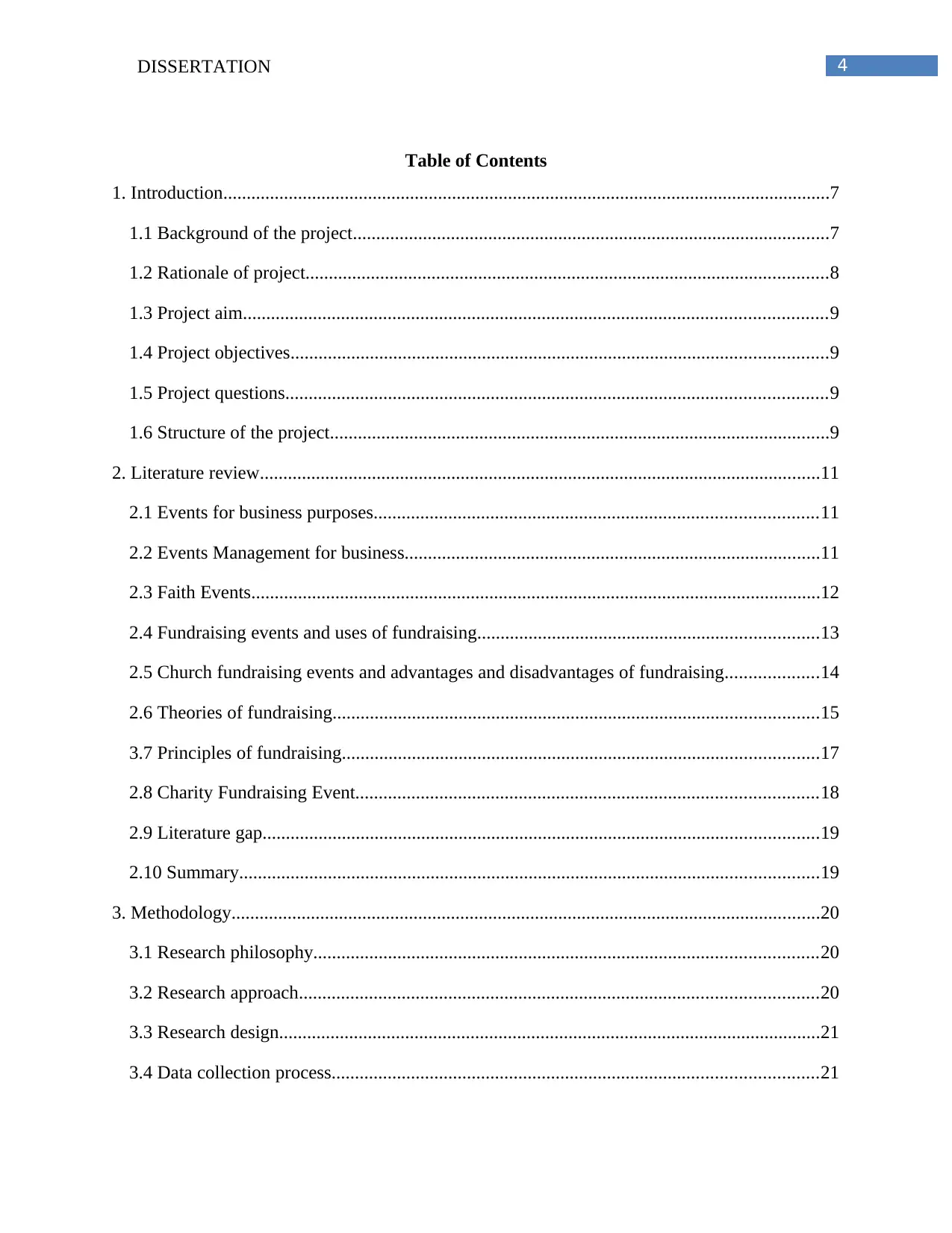
4DISSERTATION
Table of Contents
1. Introduction..................................................................................................................................7
1.1 Background of the project......................................................................................................7
1.2 Rationale of project................................................................................................................8
1.3 Project aim.............................................................................................................................9
1.4 Project objectives...................................................................................................................9
1.5 Project questions....................................................................................................................9
1.6 Structure of the project...........................................................................................................9
2. Literature review........................................................................................................................11
2.1 Events for business purposes...............................................................................................11
2.2 Events Management for business.........................................................................................11
2.3 Faith Events..........................................................................................................................12
2.4 Fundraising events and uses of fundraising.........................................................................13
2.5 Church fundraising events and advantages and disadvantages of fundraising....................14
2.6 Theories of fundraising........................................................................................................15
3.7 Principles of fundraising......................................................................................................17
2.8 Charity Fundraising Event...................................................................................................18
2.9 Literature gap.......................................................................................................................19
2.10 Summary............................................................................................................................19
3. Methodology..............................................................................................................................20
3.1 Research philosophy............................................................................................................20
3.2 Research approach...............................................................................................................20
3.3 Research design....................................................................................................................21
3.4 Data collection process........................................................................................................21
Table of Contents
1. Introduction..................................................................................................................................7
1.1 Background of the project......................................................................................................7
1.2 Rationale of project................................................................................................................8
1.3 Project aim.............................................................................................................................9
1.4 Project objectives...................................................................................................................9
1.5 Project questions....................................................................................................................9
1.6 Structure of the project...........................................................................................................9
2. Literature review........................................................................................................................11
2.1 Events for business purposes...............................................................................................11
2.2 Events Management for business.........................................................................................11
2.3 Faith Events..........................................................................................................................12
2.4 Fundraising events and uses of fundraising.........................................................................13
2.5 Church fundraising events and advantages and disadvantages of fundraising....................14
2.6 Theories of fundraising........................................................................................................15
3.7 Principles of fundraising......................................................................................................17
2.8 Charity Fundraising Event...................................................................................................18
2.9 Literature gap.......................................................................................................................19
2.10 Summary............................................................................................................................19
3. Methodology..............................................................................................................................20
3.1 Research philosophy............................................................................................................20
3.2 Research approach...............................................................................................................20
3.3 Research design....................................................................................................................21
3.4 Data collection process........................................................................................................21
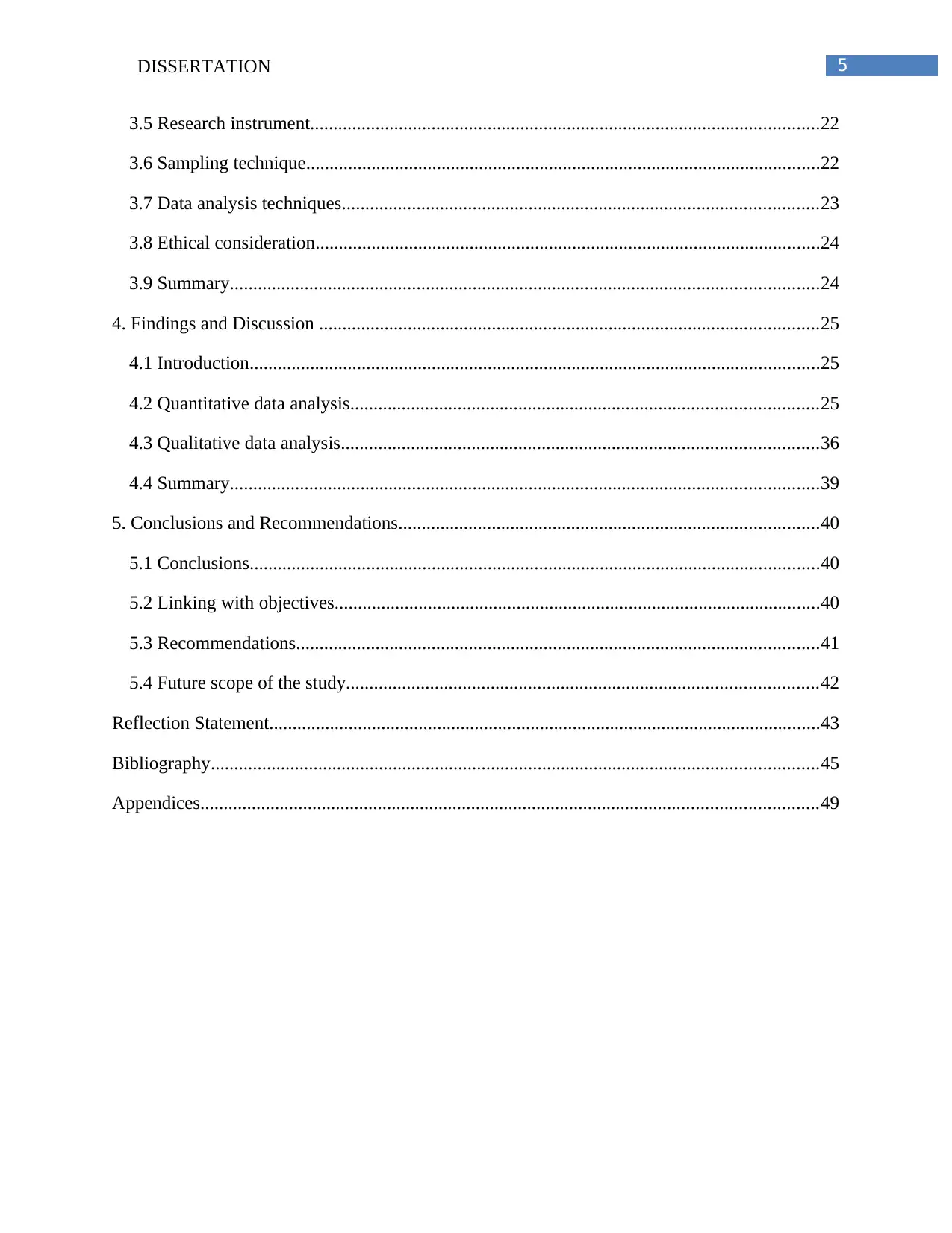
5DISSERTATION
3.5 Research instrument.............................................................................................................22
3.6 Sampling technique..............................................................................................................22
3.7 Data analysis techniques......................................................................................................23
3.8 Ethical consideration............................................................................................................24
3.9 Summary..............................................................................................................................24
4. Findings and Discussion ...........................................................................................................25
4.1 Introduction..........................................................................................................................25
4.2 Quantitative data analysis....................................................................................................25
4.3 Qualitative data analysis......................................................................................................36
4.4 Summary..............................................................................................................................39
5. Conclusions and Recommendations..........................................................................................40
5.1 Conclusions..........................................................................................................................40
5.2 Linking with objectives........................................................................................................40
5.3 Recommendations................................................................................................................41
5.4 Future scope of the study.....................................................................................................42
Reflection Statement......................................................................................................................43
Bibliography..................................................................................................................................45
Appendices....................................................................................................................................49
3.5 Research instrument.............................................................................................................22
3.6 Sampling technique..............................................................................................................22
3.7 Data analysis techniques......................................................................................................23
3.8 Ethical consideration............................................................................................................24
3.9 Summary..............................................................................................................................24
4. Findings and Discussion ...........................................................................................................25
4.1 Introduction..........................................................................................................................25
4.2 Quantitative data analysis....................................................................................................25
4.3 Qualitative data analysis......................................................................................................36
4.4 Summary..............................................................................................................................39
5. Conclusions and Recommendations..........................................................................................40
5.1 Conclusions..........................................................................................................................40
5.2 Linking with objectives........................................................................................................40
5.3 Recommendations................................................................................................................41
5.4 Future scope of the study.....................................................................................................42
Reflection Statement......................................................................................................................43
Bibliography..................................................................................................................................45
Appendices....................................................................................................................................49
⊘ This is a preview!⊘
Do you want full access?
Subscribe today to unlock all pages.

Trusted by 1+ million students worldwide

6DISSERTATION
List of figures
Figure 2.1: Fundraising relationship marketing.............................................................................17
Figure 4.1: Gender of the respondents...........................................................................................27
Figure 4.2: Working period of the volunteers...............................................................................27
Figure 4.3: Age group of the respondents.....................................................................................28
Figure 4.4: Satisfaction level in fundraising events.......................................................................29
Figure 4.5: Type of fundraising event...........................................................................................30
Figure 4.6: Numbers of fundraising events organised...................................................................31
Figure 4.7: Numbers of people supervise the fundraising events..................................................32
Figure 4.8: the Main reason for fundraising event........................................................................33
Figure 4.9: Advantage of a fundraising event...............................................................................34
Figure 4.10: the Main challenge of a fundraising event................................................................35
List of figures
Figure 2.1: Fundraising relationship marketing.............................................................................17
Figure 4.1: Gender of the respondents...........................................................................................27
Figure 4.2: Working period of the volunteers...............................................................................27
Figure 4.3: Age group of the respondents.....................................................................................28
Figure 4.4: Satisfaction level in fundraising events.......................................................................29
Figure 4.5: Type of fundraising event...........................................................................................30
Figure 4.6: Numbers of fundraising events organised...................................................................31
Figure 4.7: Numbers of people supervise the fundraising events..................................................32
Figure 4.8: the Main reason for fundraising event........................................................................33
Figure 4.9: Advantage of a fundraising event...............................................................................34
Figure 4.10: the Main challenge of a fundraising event................................................................35
Paraphrase This Document
Need a fresh take? Get an instant paraphrase of this document with our AI Paraphraser
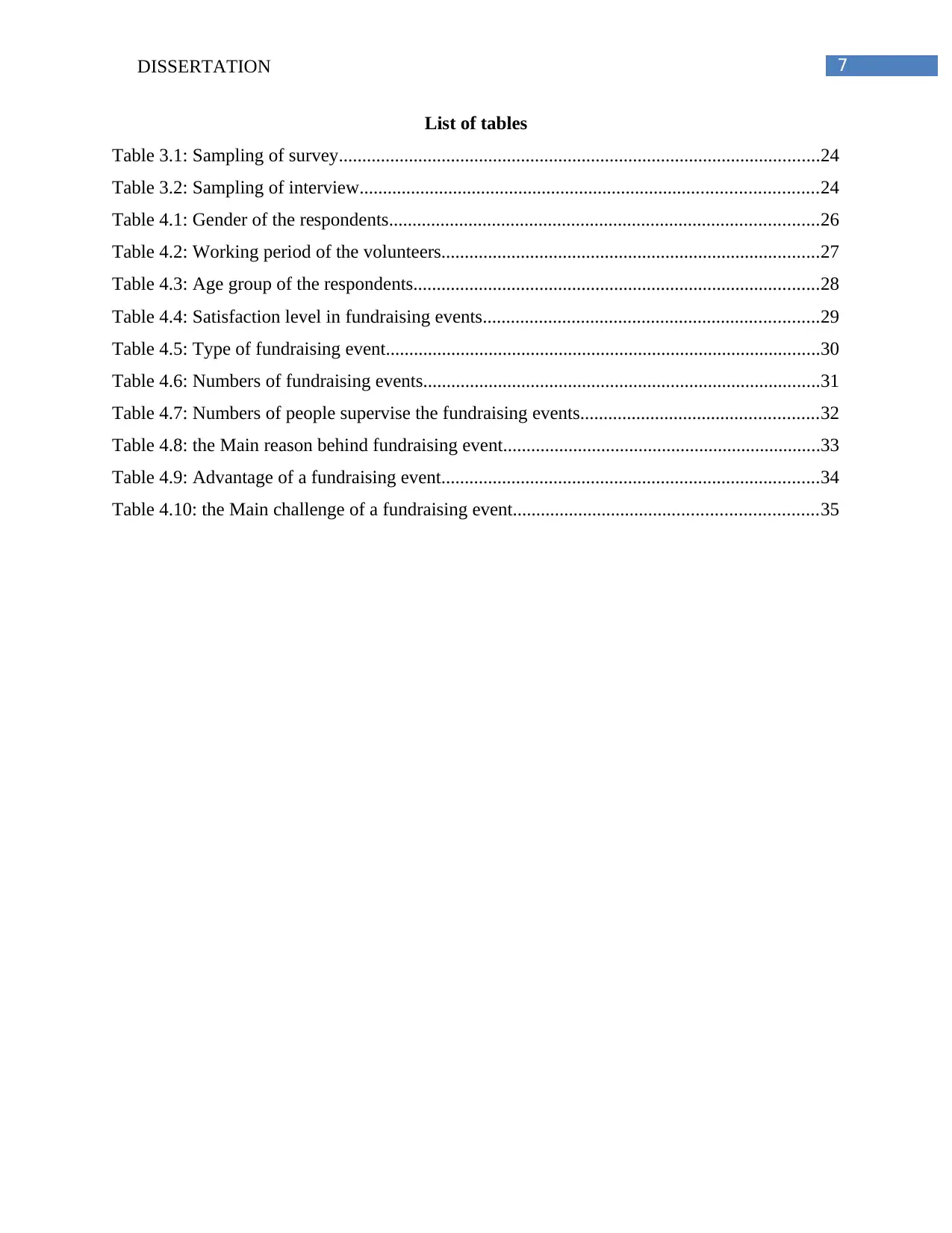
7DISSERTATION
List of tables
Table 3.1: Sampling of survey.......................................................................................................24
Table 3.2: Sampling of interview..................................................................................................24
Table 4.1: Gender of the respondents............................................................................................26
Table 4.2: Working period of the volunteers.................................................................................27
Table 4.3: Age group of the respondents.......................................................................................28
Table 4.4: Satisfaction level in fundraising events........................................................................29
Table 4.5: Type of fundraising event.............................................................................................30
Table 4.6: Numbers of fundraising events.....................................................................................31
Table 4.7: Numbers of people supervise the fundraising events...................................................32
Table 4.8: the Main reason behind fundraising event....................................................................33
Table 4.9: Advantage of a fundraising event.................................................................................34
Table 4.10: the Main challenge of a fundraising event.................................................................35
List of tables
Table 3.1: Sampling of survey.......................................................................................................24
Table 3.2: Sampling of interview..................................................................................................24
Table 4.1: Gender of the respondents............................................................................................26
Table 4.2: Working period of the volunteers.................................................................................27
Table 4.3: Age group of the respondents.......................................................................................28
Table 4.4: Satisfaction level in fundraising events........................................................................29
Table 4.5: Type of fundraising event.............................................................................................30
Table 4.6: Numbers of fundraising events.....................................................................................31
Table 4.7: Numbers of people supervise the fundraising events...................................................32
Table 4.8: the Main reason behind fundraising event....................................................................33
Table 4.9: Advantage of a fundraising event.................................................................................34
Table 4.10: the Main challenge of a fundraising event.................................................................35
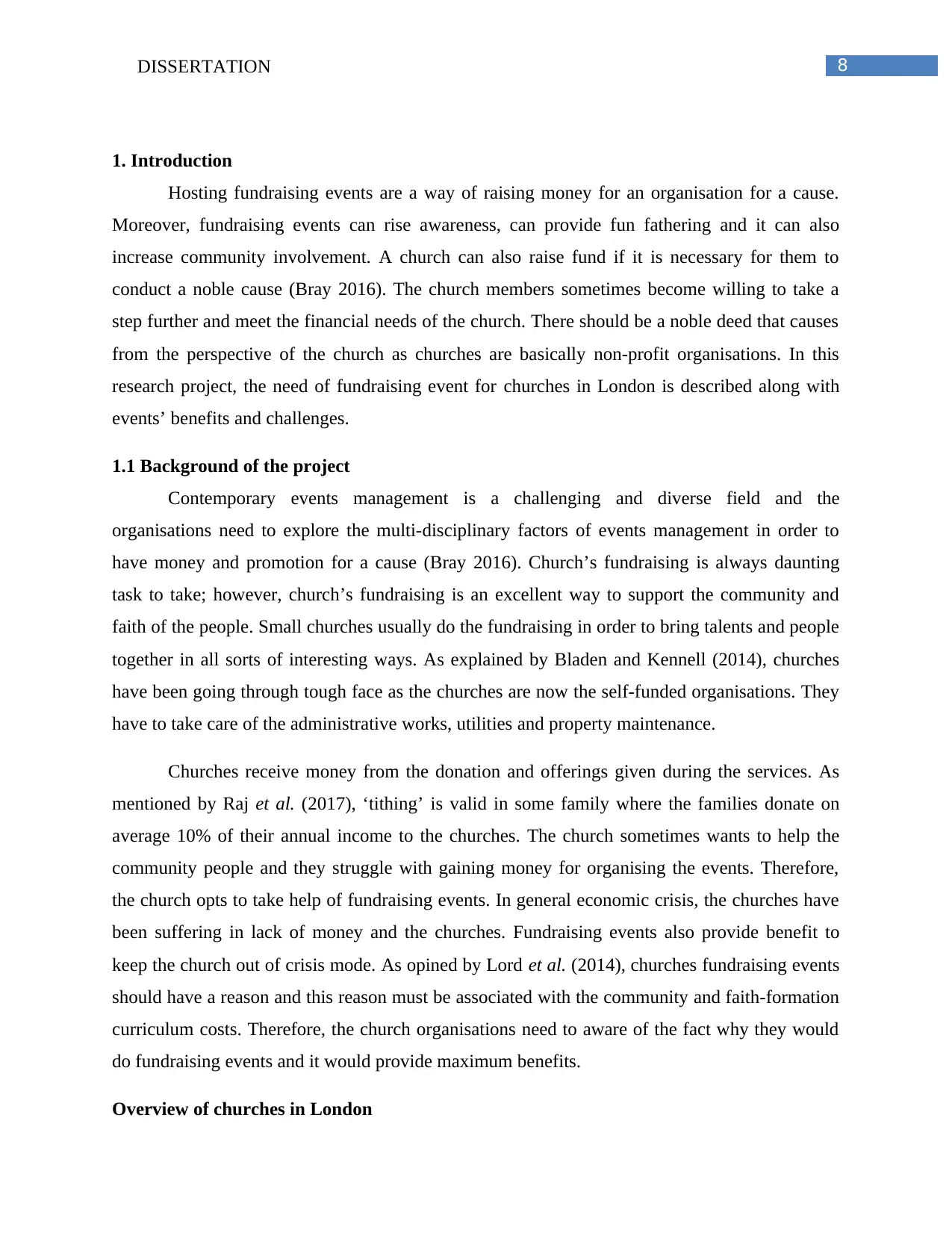
8DISSERTATION
1. Introduction
Hosting fundraising events are a way of raising money for an organisation for a cause.
Moreover, fundraising events can rise awareness, can provide fun fathering and it can also
increase community involvement. A church can also raise fund if it is necessary for them to
conduct a noble cause (Bray 2016). The church members sometimes become willing to take a
step further and meet the financial needs of the church. There should be a noble deed that causes
from the perspective of the church as churches are basically non-profit organisations. In this
research project, the need of fundraising event for churches in London is described along with
events’ benefits and challenges.
1.1 Background of the project
Contemporary events management is a challenging and diverse field and the
organisations need to explore the multi-disciplinary factors of events management in order to
have money and promotion for a cause (Bray 2016). Church’s fundraising is always daunting
task to take; however, church’s fundraising is an excellent way to support the community and
faith of the people. Small churches usually do the fundraising in order to bring talents and people
together in all sorts of interesting ways. As explained by Bladen and Kennell (2014), churches
have been going through tough face as the churches are now the self-funded organisations. They
have to take care of the administrative works, utilities and property maintenance.
Churches receive money from the donation and offerings given during the services. As
mentioned by Raj et al. (2017), ‘tithing’ is valid in some family where the families donate on
average 10% of their annual income to the churches. The church sometimes wants to help the
community people and they struggle with gaining money for organising the events. Therefore,
the church opts to take help of fundraising events. In general economic crisis, the churches have
been suffering in lack of money and the churches. Fundraising events also provide benefit to
keep the church out of crisis mode. As opined by Lord et al. (2014), churches fundraising events
should have a reason and this reason must be associated with the community and faith-formation
curriculum costs. Therefore, the church organisations need to aware of the fact why they would
do fundraising events and it would provide maximum benefits.
Overview of churches in London
1. Introduction
Hosting fundraising events are a way of raising money for an organisation for a cause.
Moreover, fundraising events can rise awareness, can provide fun fathering and it can also
increase community involvement. A church can also raise fund if it is necessary for them to
conduct a noble cause (Bray 2016). The church members sometimes become willing to take a
step further and meet the financial needs of the church. There should be a noble deed that causes
from the perspective of the church as churches are basically non-profit organisations. In this
research project, the need of fundraising event for churches in London is described along with
events’ benefits and challenges.
1.1 Background of the project
Contemporary events management is a challenging and diverse field and the
organisations need to explore the multi-disciplinary factors of events management in order to
have money and promotion for a cause (Bray 2016). Church’s fundraising is always daunting
task to take; however, church’s fundraising is an excellent way to support the community and
faith of the people. Small churches usually do the fundraising in order to bring talents and people
together in all sorts of interesting ways. As explained by Bladen and Kennell (2014), churches
have been going through tough face as the churches are now the self-funded organisations. They
have to take care of the administrative works, utilities and property maintenance.
Churches receive money from the donation and offerings given during the services. As
mentioned by Raj et al. (2017), ‘tithing’ is valid in some family where the families donate on
average 10% of their annual income to the churches. The church sometimes wants to help the
community people and they struggle with gaining money for organising the events. Therefore,
the church opts to take help of fundraising events. In general economic crisis, the churches have
been suffering in lack of money and the churches. Fundraising events also provide benefit to
keep the church out of crisis mode. As opined by Lord et al. (2014), churches fundraising events
should have a reason and this reason must be associated with the community and faith-formation
curriculum costs. Therefore, the church organisations need to aware of the fact why they would
do fundraising events and it would provide maximum benefits.
Overview of churches in London
⊘ This is a preview!⊘
Do you want full access?
Subscribe today to unlock all pages.

Trusted by 1+ million students worldwide
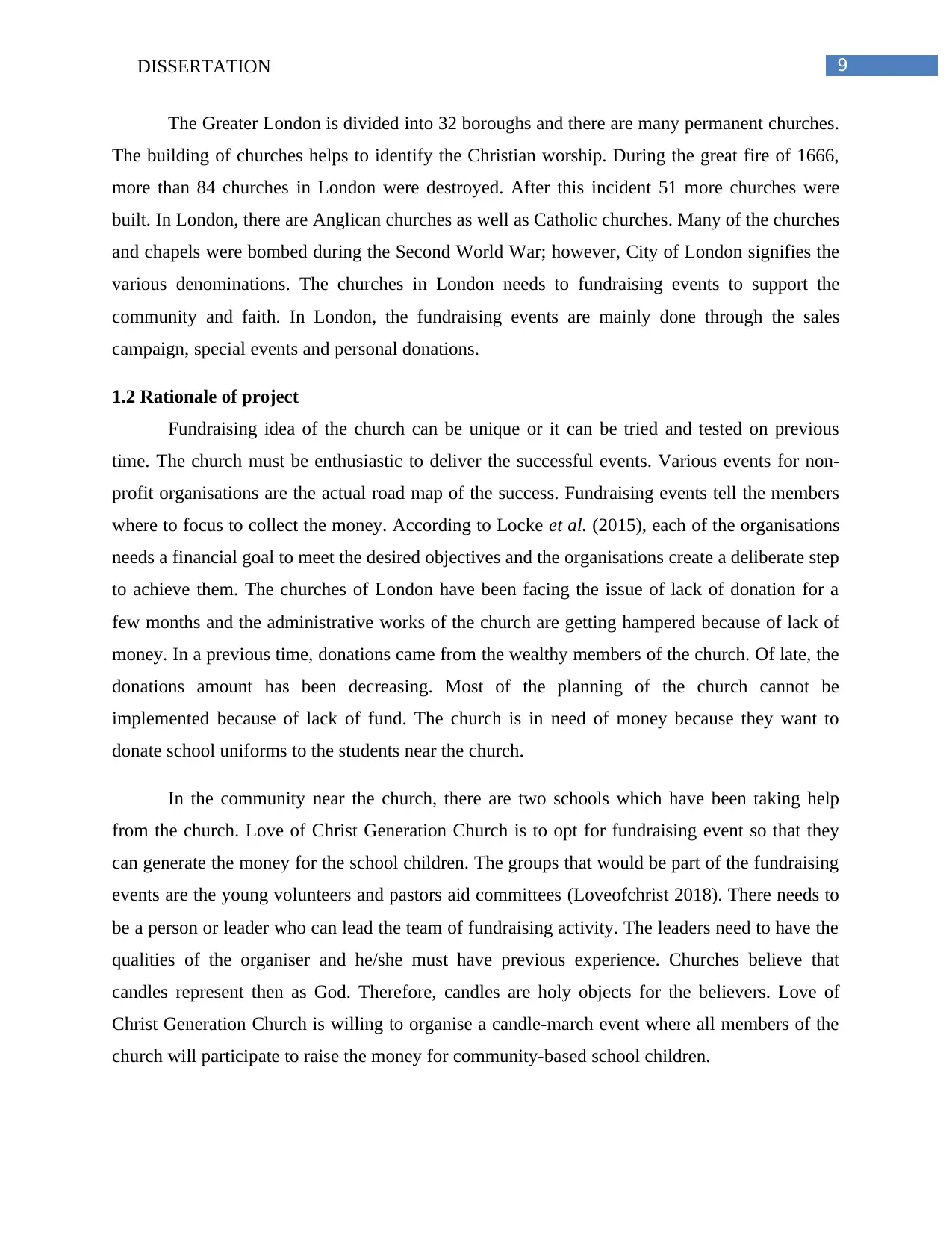
9DISSERTATION
The Greater London is divided into 32 boroughs and there are many permanent churches.
The building of churches helps to identify the Christian worship. During the great fire of 1666,
more than 84 churches in London were destroyed. After this incident 51 more churches were
built. In London, there are Anglican churches as well as Catholic churches. Many of the churches
and chapels were bombed during the Second World War; however, City of London signifies the
various denominations. The churches in London needs to fundraising events to support the
community and faith. In London, the fundraising events are mainly done through the sales
campaign, special events and personal donations.
1.2 Rationale of project
Fundraising idea of the church can be unique or it can be tried and tested on previous
time. The church must be enthusiastic to deliver the successful events. Various events for non-
profit organisations are the actual road map of the success. Fundraising events tell the members
where to focus to collect the money. According to Locke et al. (2015), each of the organisations
needs a financial goal to meet the desired objectives and the organisations create a deliberate step
to achieve them. The churches of London have been facing the issue of lack of donation for a
few months and the administrative works of the church are getting hampered because of lack of
money. In a previous time, donations came from the wealthy members of the church. Of late, the
donations amount has been decreasing. Most of the planning of the church cannot be
implemented because of lack of fund. The church is in need of money because they want to
donate school uniforms to the students near the church.
In the community near the church, there are two schools which have been taking help
from the church. Love of Christ Generation Church is to opt for fundraising event so that they
can generate the money for the school children. The groups that would be part of the fundraising
events are the young volunteers and pastors aid committees (Loveofchrist 2018). There needs to
be a person or leader who can lead the team of fundraising activity. The leaders need to have the
qualities of the organiser and he/she must have previous experience. Churches believe that
candles represent then as God. Therefore, candles are holy objects for the believers. Love of
Christ Generation Church is willing to organise a candle-march event where all members of the
church will participate to raise the money for community-based school children.
The Greater London is divided into 32 boroughs and there are many permanent churches.
The building of churches helps to identify the Christian worship. During the great fire of 1666,
more than 84 churches in London were destroyed. After this incident 51 more churches were
built. In London, there are Anglican churches as well as Catholic churches. Many of the churches
and chapels were bombed during the Second World War; however, City of London signifies the
various denominations. The churches in London needs to fundraising events to support the
community and faith. In London, the fundraising events are mainly done through the sales
campaign, special events and personal donations.
1.2 Rationale of project
Fundraising idea of the church can be unique or it can be tried and tested on previous
time. The church must be enthusiastic to deliver the successful events. Various events for non-
profit organisations are the actual road map of the success. Fundraising events tell the members
where to focus to collect the money. According to Locke et al. (2015), each of the organisations
needs a financial goal to meet the desired objectives and the organisations create a deliberate step
to achieve them. The churches of London have been facing the issue of lack of donation for a
few months and the administrative works of the church are getting hampered because of lack of
money. In a previous time, donations came from the wealthy members of the church. Of late, the
donations amount has been decreasing. Most of the planning of the church cannot be
implemented because of lack of fund. The church is in need of money because they want to
donate school uniforms to the students near the church.
In the community near the church, there are two schools which have been taking help
from the church. Love of Christ Generation Church is to opt for fundraising event so that they
can generate the money for the school children. The groups that would be part of the fundraising
events are the young volunteers and pastors aid committees (Loveofchrist 2018). There needs to
be a person or leader who can lead the team of fundraising activity. The leaders need to have the
qualities of the organiser and he/she must have previous experience. Churches believe that
candles represent then as God. Therefore, candles are holy objects for the believers. Love of
Christ Generation Church is willing to organise a candle-march event where all members of the
church will participate to raise the money for community-based school children.
Paraphrase This Document
Need a fresh take? Get an instant paraphrase of this document with our AI Paraphraser
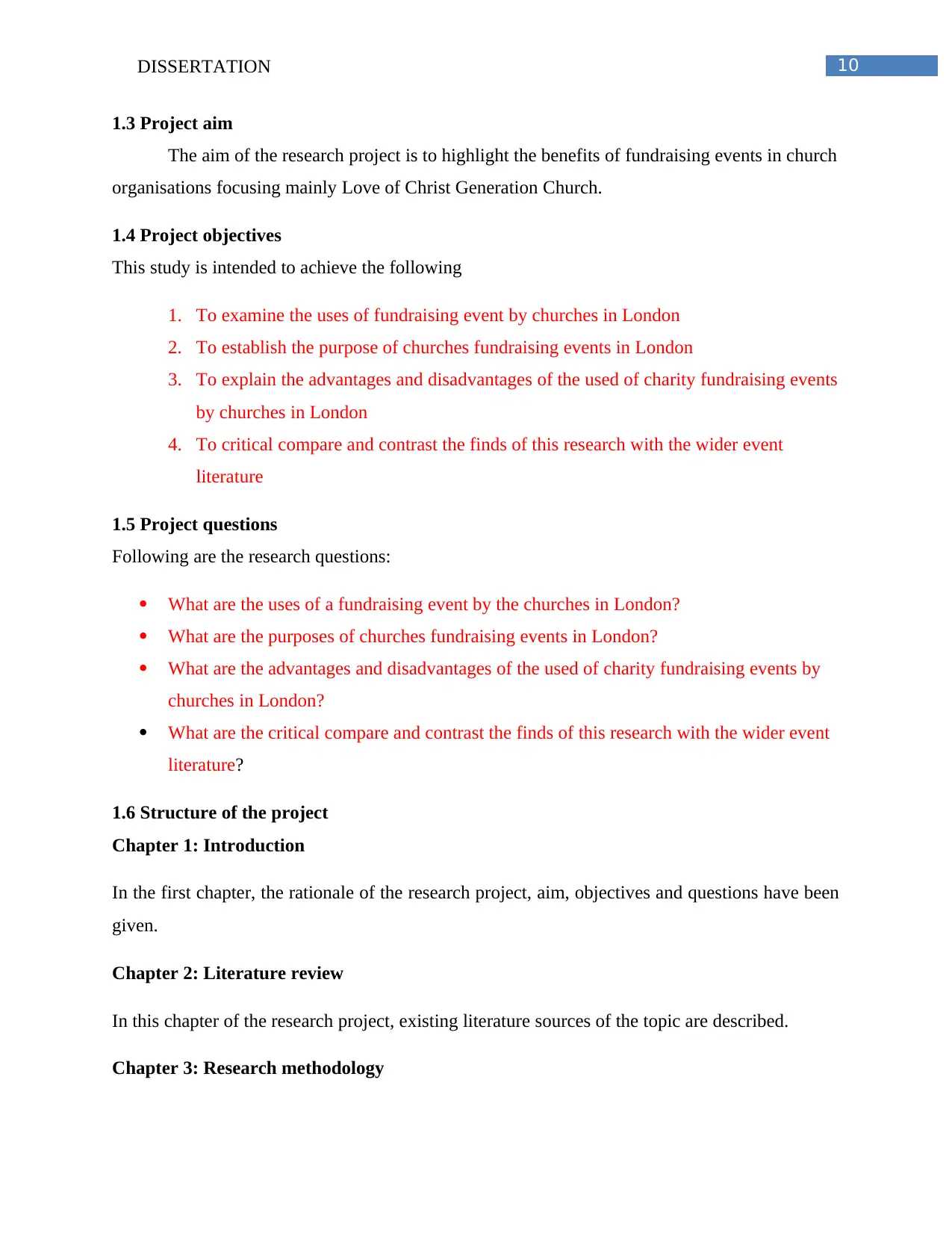
10DISSERTATION
1.3 Project aim
The aim of the research project is to highlight the benefits of fundraising events in church
organisations focusing mainly Love of Christ Generation Church.
1.4 Project objectives
This study is intended to achieve the following
1. To examine the uses of fundraising event by churches in London
2. To establish the purpose of churches fundraising events in London
3. To explain the advantages and disadvantages of the used of charity fundraising events
by churches in London
4. To critical compare and contrast the finds of this research with the wider event
literature
1.5 Project questions
Following are the research questions:
What are the uses of a fundraising event by the churches in London?
What are the purposes of churches fundraising events in London?
What are the advantages and disadvantages of the used of charity fundraising events by
churches in London?
What are the critical compare and contrast the finds of this research with the wider event
literature?
1.6 Structure of the project
Chapter 1: Introduction
In the first chapter, the rationale of the research project, aim, objectives and questions have been
given.
Chapter 2: Literature review
In this chapter of the research project, existing literature sources of the topic are described.
Chapter 3: Research methodology
1.3 Project aim
The aim of the research project is to highlight the benefits of fundraising events in church
organisations focusing mainly Love of Christ Generation Church.
1.4 Project objectives
This study is intended to achieve the following
1. To examine the uses of fundraising event by churches in London
2. To establish the purpose of churches fundraising events in London
3. To explain the advantages and disadvantages of the used of charity fundraising events
by churches in London
4. To critical compare and contrast the finds of this research with the wider event
literature
1.5 Project questions
Following are the research questions:
What are the uses of a fundraising event by the churches in London?
What are the purposes of churches fundraising events in London?
What are the advantages and disadvantages of the used of charity fundraising events by
churches in London?
What are the critical compare and contrast the finds of this research with the wider event
literature?
1.6 Structure of the project
Chapter 1: Introduction
In the first chapter, the rationale of the research project, aim, objectives and questions have been
given.
Chapter 2: Literature review
In this chapter of the research project, existing literature sources of the topic are described.
Chapter 3: Research methodology
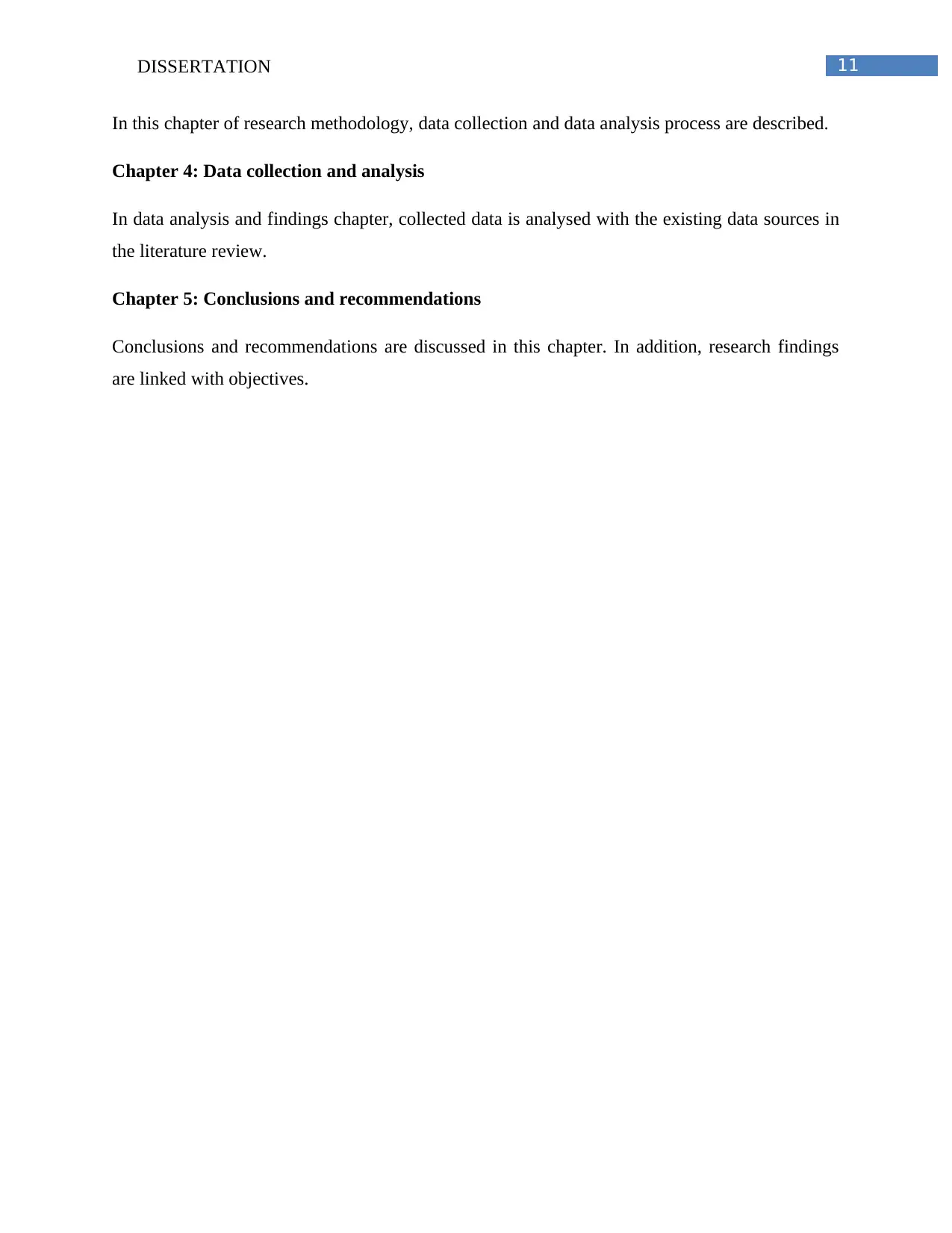
11DISSERTATION
In this chapter of research methodology, data collection and data analysis process are described.
Chapter 4: Data collection and analysis
In data analysis and findings chapter, collected data is analysed with the existing data sources in
the literature review.
Chapter 5: Conclusions and recommendations
Conclusions and recommendations are discussed in this chapter. In addition, research findings
are linked with objectives.
In this chapter of research methodology, data collection and data analysis process are described.
Chapter 4: Data collection and analysis
In data analysis and findings chapter, collected data is analysed with the existing data sources in
the literature review.
Chapter 5: Conclusions and recommendations
Conclusions and recommendations are discussed in this chapter. In addition, research findings
are linked with objectives.
⊘ This is a preview!⊘
Do you want full access?
Subscribe today to unlock all pages.

Trusted by 1+ million students worldwide
1 out of 54
Related Documents
Your All-in-One AI-Powered Toolkit for Academic Success.
+13062052269
info@desklib.com
Available 24*7 on WhatsApp / Email
![[object Object]](/_next/static/media/star-bottom.7253800d.svg)
Unlock your academic potential
Copyright © 2020–2025 A2Z Services. All Rights Reserved. Developed and managed by ZUCOL.





